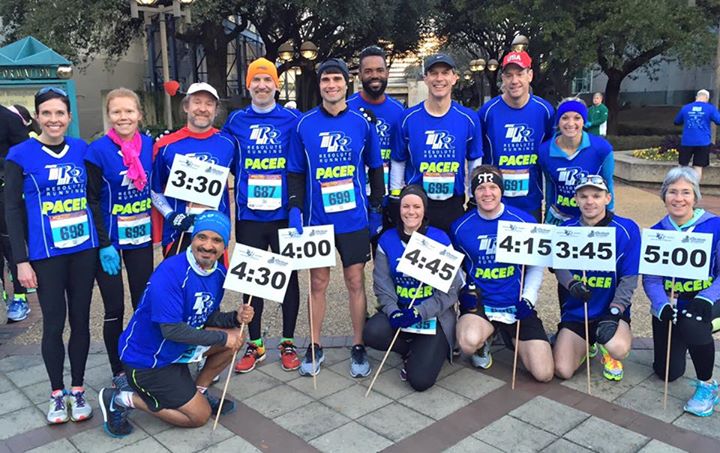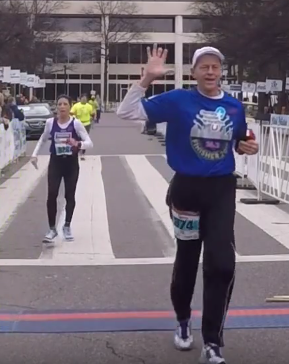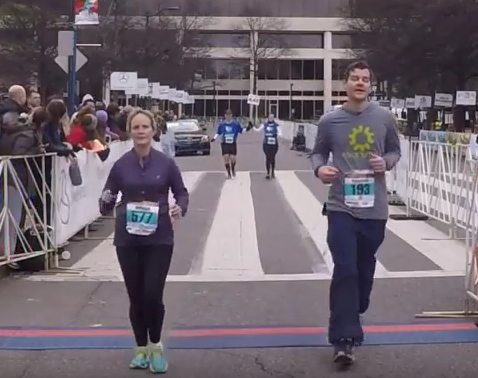I have run dozens and dozens of races. On most occasions my goal was to run as fast as I possibly could on that day. Many times I was trying to set a Personal Record (PR). A few times, however, I was just out there to enjoy the experience (the San Francisco Half Marathon comes to mind). When the time came to sign up for Mercedes 2016, I considered my options. In the fall I had just run three fast (for me) half marathons. There wasn’t enough time to train fully for a fast marathon. And I was planning to run 2 ultramarathons in the spring. So where did that leave me? I should run the Mercedes Marathon, but I should use it as a training run rather than a race. I knew that Trak Shak and Resolute Running were providing the pacers for the race, so I inquired about pacing. I simply wanted to learn more about pacing, but before I knew it I was signed up as an official pacer. Little did I know what would come from that encounter.
The first order of business was to ramp up my mileage so that I would be able to complete the distance. I had a good base, so a few, quality weekend long runs would be enough to get me where I needed to be. As I trained for the race, I knew that I would be assigned a pace group that was very manageable for me. The rule of thumb is to assign a pace group time 30-60 minutes more than a pacer’s recent best time. This meant I would likely be assigned anything from the 4 hour, 15 minute to 4 hour, 45 minute group. Knowing this fact completely took much of the pressure off my training. The constant pressure to hit a certain pace on each run was removed. I simply had to focus on accumulating mileage and time on my feet. And the gradual, unrelenting anxiety that leads up to race day was conspicuously absent as well.
I was paired with a running friend and teammate, Stacy Peterson Williams, for the 4:45 group. Neither of us had ever paced a race before, much less a marathon (although we each had run 5 marathons before). Our only anxiety was how to pace (or, rather, how not to fail at pacing). We did some runs with miles at our prescribed marathon pace. We planned as best we could. We talked with Alex Morrow of Resolute Running who gave us some tips. The two main things he told us were to bring in the group on time and to make sure the runners had a fun experience. Having completed several entertaining long runs together, Stacy and I were confident we would all have a good time (pun intended).
Race day promised cool temperatures and a big crowd. We were excited to meet some new runners. As we took the official Mercedes Marathon Pacers 2016 group photo, each pair of pacers was given their official sign. We had seven pace groups covering 15 minute increments from 3:30 to 5:00. The organizers had assembled a wonderful group of people. Some runners, like Suman Silwal, had paced many times before; some were rookies like Stacy and me.
3:30: Cary Morgan / Micah Morgan
3:45: Ann Thomas / Andrea Austin
4:00: Trey Whitt / Jabe McCcoy
4:15: Bradley Wells / PJ Strickland
4:30: Suman Silwal / Randy Stanford
4:45: Dean Thornton / Stacy Williams
5:00: Kat Richardson / Eric Thomas
We looked snazzy in our matching pacer shirts. It was time to run!

Trak Shak / Resolute Running Mercedes Marathon Pacers
As we made our way to the starting line, we were still not sure how many people would join us. It dawned on us as we lined up that we would likely have some half marathoners with us on the first loop. Double the fun! As we gazed toward the starting line, we saw the assembled mass of runners huddled together for warmth. Just above the collective heads of the crowd, we could see the pacing signs like small little beacons. We tried to meet a few runners who anticipated staying with us throughout the race, but the organized chaos prevented a full meet and greet. Before we knew it, the race had begun.
Unless you are in the very front or the very back, the first few miles of the Mercedes Marathon are very crowded. Runners are jostling for position. Some surge ahead, some get passed. For the first few miles, Stacy and I weren’t really sure who was with us, so we just tried to maintain our steady pace. For the 26.2 mile marathon, a time of 4:45 translates to a pace of 10:52 per mile. But anyone who has ever run Mercedes (or any other marathon) knows that runners end up running slightly longer than 26.2 miles. It’s simply not possible to run the shortest possible distance on the course (which is how it is measured). Past experience has taught me that most races are long by 0.01 miles per mile which would translate to a total close to 26.46 miles (26.2 + 0.262 miles). Planning on that distance, we planned to run a pace of about 10:48 minutes per mile.
As the miles rolled by, we began to get acquainted with some of the people around us. The most engaging runner was George, a 69 year old man from Georgia who had only taken up running a few years earlier. Running had helped him lose 60 pounds. He told us stories about himself and kept us thoroughly entertained (even though that was our job). If he got ahead of us or fell behind a little, he would call out for us to make sure we were still there. One of our running friends was worried that she would not be able to keep up our pace for the half marathon. Well, at around mile 6 she and another pacee (noun; 1. a person or thing that is paced -- yes, I made up this word) took off ahead of us and never looked back.
Being so familiar with the course, we were able to help those around us know what was coming. We were a mobile information kiosk:
“When is that hill I keep hearing about?”
“How long is the next hill?”
“Exactly how many hills are on this course?”
“Where is the next water stop?” (or, the opposite question...)
“Where is the next porta-potty?”
Stacy and I worked well as a team. We passed the 4:45 sign back and forth every 2 miles. We alternated water stops with one of us holding the sign and keeping the steady pace while the other slowed to grab water or Powerade. If one of us get a little ahead of pace, the other would offer a gentle reminder to slow down. We each scanned the runners around us looking for anyone struggling or in need of diversion.
At the Full/Half marathon divide at Pepper Place on 2nd Avenue, we were separated from some of the half marathoners who had been with us. As we ran along our parallel routes, we could tell one of them was struggling to maintain pace. As Stacy and I debated which of us would go over to help her, George promptly scrambled to her side offering her words of encouragement. (He was again doing our job!) She smiled and kept on running.
At mile 12.5 we heard sirens and car horns blaring behind us. We looked back to see several police cars with lights flashing. We briefly wondered what sort of emergency had happened until we realized that the leader of the marathon was heading down the home stretch. We marveled at his fast and easy stride as he swiftly moved past us on his way to the finish line. Stacy and I did our best to encourage the runners around us as it dawned on them that we still had another lap to go.
While the first loop of Mercedes can feel a little crowded, the second loop can feel a little lonely. When the 3000+ half marathoners turn off for the finish line, the 1000 or so marathoners and relay racers carry on. We continued to have runners surge ahead of us while others dropped back to us trying to hang on. Stacy and I took turns telling stories trying to distract and entertain.
As we passed through the BUTS aid station at Avondale Park (I never did get my piece of bacon), we knew we were in the home stretch. Stacy and I really ramped up the good vibes and encouragement for our merry little band of pacees. Debbie, with a PR of 5:07, was trying to break 5 hours for the first time. Terry, who had fallen back around mile 18, managed to keep us in sight while mustering the energy to rejoin us near the end. Allen, running in long gym shorts, had stayed beside or just ahead of us the whole race and continued on as steady as a metronome. Several times over the last few miles, I checked on Kenneth who showed signs of fatigue and discomfort but never lost our group or complained out loud. Michael, once thought lost, rejoined us and even forged ahead a little. In the last 2 miles we even picked up several new runners as they fought their way to the end. At mile 23, Chris was all smiles as we caught up to him. I gave him a hearty handshake and exhorted to fall in line with us. He said he would try. At mile 24, we caught David doing something between a jog and a walk. He was able to pick up his pace and join us for the next mile with a good attitude on his face and in his voice. But he soon fell behind our group. At mile 25, Richard was walking with a visible limp. Stacy called him by name, imploring him to follow us to the finish. Taking stock of his pain, he managed to start running again and join us.
When we made the next to last turn from 20th Street onto Park Place, Stacy and I fell back slightly to allow our group to enjoy their moment of glory. Michael surged ahead like he was running a 5K. Terry ran with new vigor passing us for the first time in the race. Allen, Richard, Kenneth, and Debbie steadily made their way across the finish line. Debbie finished in 4:43, a PR of 24 minutes! As Stacy and I came down the final straightaway, it was bittersweet. We had had such a good time we didn’t want it to be over. But, as we discussed during the final stretch, 26.2 miles -- even at a comfortable pace -- is still 26.2 miles. It felt good to finish. As we turned around, we felt great joy to see David and Chris finishing strong right behind us.






And then it hit us: it was over. We made our way to the after-party in Boutwell. We found a table of friends and dug into our barbecue sandwiches. We told stories from the race and listened as others did the same. We sought out the pacers of the other groups to ask about their experiences. They all had much the same thing to say: what an honor and joy it was to help others reach their goals.
In the aftermath of the race, Facebook and Twitter exploded with stories of success and enjoyment. Runners and pacers alike described what a great experience it was. Here is just a sample of the comments after the race:
Runner in 4:30 group: “Suman and Randy were great. Thanks for getting me across the finish line for my fastest Mercedes in the past 6 years.”
Pacer in 4:30 group: “I had so much fun pacing this bunch and more!!! A life of a pacer is not all about carrying that sign, it is about motivating runners to finish their first or next marathon on time while having a lot of fun! 4:29:12 finishing time! 4:30 group had fun pacing... It was fun time start to finish. We had few first timers, few PRs, and few repeaters who ran 4:30 last 3 times.”
Runner in 4:00 group: “I need the contact info for Trey who commanded the 4:00 group today. I want to give him & the other gentleman who helped some kind of gratuity for their help. As I was coming up 20th street at the end I almost broke-out in tears for getting a sub-4.”
Runner in 3:45 group: “Thank you again for pacing yesterday! There is no way I could have finished without you and the rest of the group pulling me along!!"
Runner in 3:45 group: “I ran with you in the pace group today. I didn't see you after the race but wanted to say Thanks so much!!! For your encouragement!!! I couldn't have done it without you. Finished at 3:42 which was a 11 minute PR. So good to meet you. Thanks again!!!!”
Pacer in 3:45 group: “I have had four people who ran with [our group] tell me they were able to PR!”
Message to Pacer in 3:45 group: “My friend Bethany said that you were just chatting away and being so sweet to everyone and she was about to die but she kept up with y'all till Mile ten. She was doing the half and got a PR.”
Pacer in 4:15 group: “Likely one of the most rewarding things I've got to do... especially when we got bring across this young Japanese guy who was cramping so bad he couldn't hardly walk... he was crying and so thankful, it was his first marathon!”
Pacer in 3:30 group: “I start with some sort of costume. I also try to talk the whole time. I tell stories of our engagement/wedding. I throw out hypothetical questions such as one I heard on the radio, ‘Would you rather have $50k in cash or $100k in Amazon gift cards?’ I'm constantly trying to cause a distraction. They seem to enjoy it.”
Runner: “I had fun with the 4:30 group on the first loop, and then I lost them and eventually got caught by [the 4:45 group]. I fell off a bit at the end, but I almost caught up. I finished right behind you at 4:43:37, a 35 minute PR for me. From the gentle encouragement to Suman's rowdy coaching, thank you to all the pacers!”
Pacer in 4:45 group: “Pacing Mercedes was SO MUCH FUN!! Met some amazing runners along the way and had a great time with co-pacer Dean! First time pacing for us both, and we were honored and thrilled to do it. Hearing we helped a few people make it to the finish line and even PR made it just that much better! Running people are the best people! Congrats to all the runners that ran their hearts out today!”
If you are looking for a new and rewarding running experience, I highly recommend leading a pace group. The physical rewards are much the same, but the emotional and interpersonal rewards are unique and wondrous. So, here’s to all the pacers that have helped me in the past. I don’t think I adequately thanked you enough for your efforts. I’ll definitely be back for more.



































